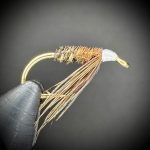Teeny Nymph

Nymph
Tied By Joe Glessner
Hook: Any Wet Fly Hook, Size #14-2 (Wholesale Fly Company M6, size #10 as tied)
Thread: 8/0 Veevus, White
Body Parts: body
Materials: Cock Ringneck Pheasant Tail, 6-20+ fibers depending on hook size
Notes:
The Teeny Nymph was first tied by Jim Teeny in May 1962, with its commercial availability in 1971. Initially designed for trout, it marked the start of Jim Teeny’s fishing career and has since been credited with setting world fly fishing records. Jim Teeny himself has stated that he has not fished with any other fly since creating the Teeny Nymph (and its variants), underscoring its reliability and versatility.
This pattern has been used successfully in various contexts, including tenkara fishing, and is noted for its ability to catch fish in diverse environments from mountain streams to large rivers. Jim Teeny often states that the Teeny Nymph catches fish in every water and every season, which seems to have some truth to it.
Jim ties these using a variety of colors of thread and dyed pheasant tail, giving the pattern a rather unusual ability to imitate a wide variety of bugs. The possibilities are almost unlimited.
For trout, recommended colors include Natural (Brown), Black, Caddis Green, Antique Gold, and Ginger.
For salmon and steelhead, colors such as Fluorescent Pink, Ginger, Black, Fluorescent Green, Red, Purple, and Flame Orange are recommended.
This pattern is deceptively simple, it’s just thread and pheasant tail fibers. The most difficult part is tying the pheasant tail so that the barbs are the “correct” length at the end (they should just brush the point of the hook).
I usually tie the original pattern in size #12-14 and use the “double” variant for larger sizes because it’s easier to get the fibers tied the correct length, however the double variant uses almost three times as many barbs.
The sample I’ve tied here technically has barbs that are too long, but one of the great things about this pattern is that it really doesn’t matter. Longer barbs will only give the nymph more motion in the water.
If you’ve never fished a Teeny Nymph you should definitely tie some and see what you’re missing!
Tying Instructions:
- Mount the hook in your vise and attach the thread using a jam wrap, creating an index point one eye length behind the eye of the hook.
- Using touching turns, wrap back to a point on the hook shank just shy of the hook point.
- Select an appropriate number and length of Pheasant Tail barbs for the hook size you are using. Make sure the tips are aligned and trim the butt ends flush.
- With the butt ends of the Pheasant Tail barbs at about the midpoint of the hook shank, mount the barbs to the top of the hook with the tips facing the bend of the hook, and take touching turns back to about halfway between the point and barb of the hook.
- Return your thread to the index point.
- Keeping the barbs flat, wrap them forward to the index point using touching turns and tie them off with the tips extending over the eye of the hook.
- Carefully fold the tips back and sweep them down to form a beard.
- Wrap over the barbs just far enough to hold them in place, and form a small thread head.
- Whip finish and apply head cement or UV resin to add durability to the fly.
You can optionally add a wire rib to this fly using small copper or gold wire to protect the pheasant tail barbs. If you choose to do this, it is wise to counterwrap the pheasant tail barbs and then wrap the wire the same direction you wrap your thread to make it easier to helicopter off the wire excess.
